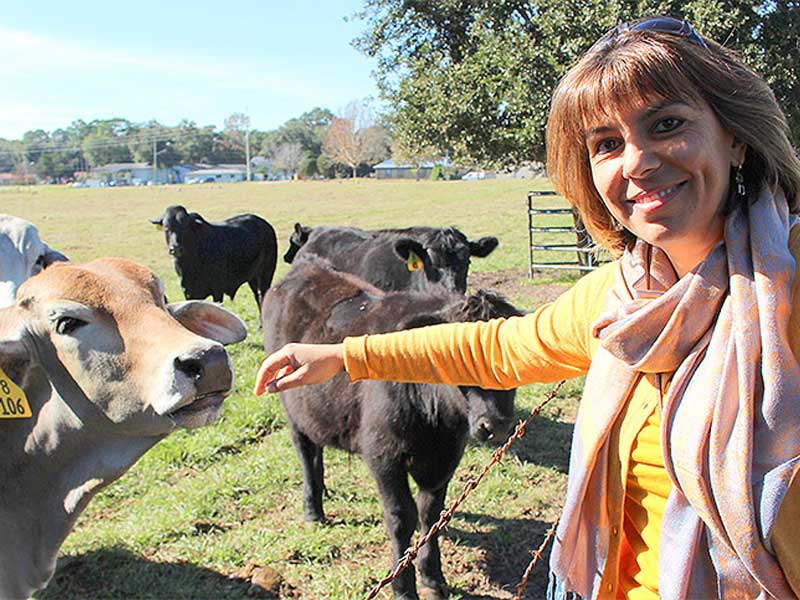by ERIKA ALDRICH
photo by MARC HELLER/E&E News
There’s no mistaking that The Sunshine State sees its share of hot weather, and Florida beef cattle feel the heat too. Recent studies have confirmed that both beef and dairy cattle are healthier and more productive at cooler temperatures, and there are many ways that beef producers can help their herds to stay cooler, such as offering more shade.
However, the approach of University of Florida Institute of Agricultural and Food Sciences (UF/IFAS) researcher, Raluca Mateescu, is a little different. Her current work focuses on helping to develop a breed of cattle that is able to take Florida’s heat and humidity.
It’s research that’s not just for Florida cattle producers, either. As temperatures rise due to climate change, Mateescu’s research will become more relevant as other parts of the country continue to see a greater average of hotter temperatures.
Building the Cow of the Future
Mateescu is an Associate Professor of Quantitative Genetics and Genomics with the Department of Animal Sciences at UF, working mainly with UF herds, including indicine cattle like Brahmans.
“The main goal of my research program is identifying the genetic mechanisms responsible for superior thermal tolerance in indicine influenced cattle,” she explains, with an aim of developing “effective genomic selection and management tools the industry can use to mitigate the effects of heat stress on production efficiency and reproductive function critical for enhancing productivity of the U.S. livestock industry and securing global food supplies.”
In short, her research is focused on identifying those genes and genetic variations that control a cow’s ability to tolerate heat. Then, those genes can eventually be targeted through breeding and other methods to develop cattle that will be able to meet the demands of a growing world population in the face of rising global temperatures.
She maintains that her current “research right now aims at discovering the genetic variants controlling thermotolerance.” Thermotolerance, or the ability to withstand heat or cold, “is a difficult trait to measure,” Mateescu shares, and “therefore difficult to improve through classical selection.”
Because of this difficulty in targeting thermotolerance traits through selection alone, Mateescu’s research delves into the DNA. “We developed large populations where we measured thermotolerance and now we look for genetic markers, or small pieces of DNA, with a known location on a chromosome and associated with this trait,” she explains. “If a set of genetic markers affecting thermotolerance can be identified, we can use this genetic information in selection to identify genetically superior animals early in life.” Currently, Mateescu has UF herds and others at her fingertips to search out those DNA markers that affect a cow’s ability to withstand heat.
Pooling From a Large Herd
Mateescu has an array of breeds to choose to study, and it’s an important point. “Substantial differences in thermal tolerance exist among breeds and among animals within breeds indicative of opportunities for selective improvement,” she explains. Each breed will have its own desirable traits—either for heat-tolerant traits or those traits desired by producers and consumers—and accompanying DNA to bring to the table.
“At UF we have a purebred Brahman herd and a multi-breed herd with animals from 100% Angus to 100% Brahman. On the commercial side, I work with the Seminole Tribe of Florida and utilize their Brangus animals.” she explains. Each breed has traits that can be used to build the “’the cow of the future’ with high productivity and resistant to heat stress,” as Mateescu puts it.
“For example,” she explains, “Bos indicus (Brahman) cattle exhibit increased resistance to many environmental stressors relative to Bos Taurus (Angus), but tend to have slower growth, lower fertility and poor meat quality as they have not been as intensively selected for these traits as specialized Bos taurus breeds.” The Sunshine State is the perfect place to develop a cattle breed that has traits that check all the boxes concerning productivity, those that affect what consumers want, and those concerning heat tolerance. According to Mateescu, both Angus and Brahmans “are also ideal for research on genomic technology for selection and management tools for Florida beef producers to improve meat quality (tenderness, juiciness, palatability), nutritive value and healthfulness of beef from more adaptable (thermotolerant) indicine influenced cattle.”
Research Details
Mateescu maintains that her research’s long-term goal “is to develop the knowledge and tools the cattle industry needs to increase tolerance to heat stress, while simultaneously allowing for increased efficiency of production, reproduction, and meat quality.”
She utilizes a holistic approach that includes a wealth of data, from genotyping 250,000 genetic markers for the animals to measuring properties like sweating rates, coat scores, body condition scores, and the size and number of an animal’s sweat glands.
It also includes data and research that focus on the end-product: beef. “Beef quality, nutritional, and health value are critically important determinants of consumers’ satisfaction,” Mateescu explains. “Improving these attributes will increase demand for beef, improve the economic position of the beef industry and ensure a sustainable supply of high quality, nutritious protein.” While Mateescu’s research is “at the beginning of the process,” she has a bit to share with beef producers as an example
. “Our research shows that coat properties are related to the ability to maintain a lower body temperature under hot and humid conditions.” She advises producers to “evaluate their cattle based on coat score (we use a 1-5 score system, and most of our animals are either 1 or 2, with a few having a coat score of 3) and select against animals with large coat scores.”

